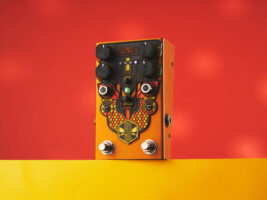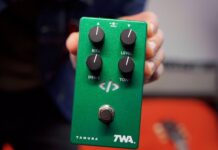
Beetronics Larva review – a speed-ramping phaser with a couple of twists
£239/$249, beetronicsfx.com
What do you see when you look at the Beetronics Larva? A large pedal with a daunting number of knobs and switches? Extravagantly ornate styling that calls to mind the LA company’s two zaniest and most complicated creations, the Zzombee and Seabee? Relax – it’s all an optical illusion.
READ MORE: Crazy Tube Circuits Heatseeker review: “You don’t need to be an AC/DC geek to be thunderstruck by the range of hard-rocking tones on offer here”
What is the Beetronics Larva?
First things first, what is morphing? Basically it’s Leslie-style ramping from one sound to another. Switch the Larva on and you’re dealing with a simple phaser, controlled by the rate and depth knobs at top-left; now hold down the left footswitch for a moment and it will start morphing into a second setting, controlled by a matching pair of knobs on the right. Congratulations, you are now a fully qualified morpher.
Image: Adam Gasson for Guitar.com
The two slightly smaller dials are for adjusting that transition time and the intensity of the phaser’s resonance, while two mini-knobs in the centre look after the input gain – the Moogerfooger-inspired preamp has some proper overdrive on tap – and output level.
That just leaves two toggle switches – one for selecting how the morphing feature moves back and forth, and one for the operating mode: standard phaser, extra-wobbly vibe or, strangely, just the preamp without any modulation. In case anyone’s in the market for a non-phasing phaser…
Image: Adam Gasson for Guitar.com
And the LEDs? They just move across from left to right, and turn from blue to pink, to indicate morphing status. They are cute.
What does the Beetronics Larva sound like?
Sorry, bit of a spoiler earlier on – but ‘just really nice’ is the best way to describe virtually everything this phaser does. The obvious way to set it up is with a slow, shallow sweep on one side and a rapid wibble on the other; in both cases the core tone will be sweet and musical, with resonance dialled in to taste. Extra-slow morphing is the most fun, but you can actually double-tap on the bypass footswitch for instant hopping between your two settings.
Part of the reason for that innate sweetness is the preamp – it’s warm and fluffy, keeping everything smooth and preventing any harshness at the top of the phaser’s arc. It ranges from clean-ish to quite heavily overdriven; the only snag, arguably quite a big one, is that you can’t switch it off or dial it out completely to hear the phasing effect pure and uncoloured.
And here’s another snag, necessitated by that double-tap feature on the bypass switch: hit it once to turn the Larva off, and it’ll take a moment to respond because it has to wait to see if a second tap is coming. This probably isn’t going to ruin anyone’s night, but it’s frickin’ annoying and should surely have been avoided somehow.
Should I buy the Beetronics Larva?
Yes, you should buy the Larva because it’s absolutely gorgeous. But then again, no, you shouldn’t buy the Larva because it’s absolutely infuriating. Can you tell I’m a little bit torn here? But that’s what it boils down to: if you only care about the tones, you’ll struggle to find a nicer phaser than this; but if you demand technical perfection in all areas of stompbox functionality, it might just drive you mad.
Beetronics Larva alternatives
It’s a very different beast to the Larva, but the Heptode Virtuoso (€192) is a beautiful-sounding phaser that offers ramping between slow, medium and fast speeds. You might also look at the Caroline Arigato ($219/£229) and SolidGoldFX Aurras ($209/£189.99).
The post Beetronics Larva review – a speed-ramping phaser with a couple of twists appeared first on Guitar.com | All Things Guitar.
Source: www.guitar-bass.net













